Located in the south of Spain and the capital of Andalusia, Seville is, undoubtedly, the cultural center of the Iberian country, counting on an exciting historical wealth. With a Mediterranean climate, it is capable of bewitching anyone who visits it., swimming between deep-rooted traditions like the sun, the frills, and the tree, Beer, the Spanish guitar or the smell of orange blossom; and the Guadalquivir, that crosses the city gives us the opportunity to have wonderful charming bridges and magical sunsets.
- Constitution Avenue
- Cathedral and Giralda of Seville
Direction: Avda. of the Constitution, 41004 Sevilla
Schedule: Monday to Sunday from 8.00 a 14.00 h, and of 16.00 a 19.00 h. It is recommended to go with advance entry.
Phone: 902 099 692 - Reales Alcázares
Direction: Patio de Banderas, 41004 Sevilla
Schedule:
01/10 – 31/03: Monday to Sunday, and holidays of 9.30 a 17.00 h
01/04 – 30/09: Monday to Sunday, and holidays of 9.30 a 19.00 h
Phone: 954 502 324 - General Archive of the Indies
Direction: Avda. of the Constitution, 41004 Sevilla
Schedule: Monday to Saturday from 9.30 a 17.00 h, and Sundays of 10.00 a 14.00 h
Phone: 954 500 528 - Santa Cruz neighborhood
- Water alley
Direction: starts in Plaza Patio de Banderas 3, 41004 Sevilla
Schedule: We recommend reserving guided tours of Barrio de Santa Cruz in advance to reserve the place. * - Los Venerables Hospital
Direction: Plaza de los Venerables, 8
Schedule: Monday to Sunday from 10.00 a 20.00 h.
Phone: 954 562 696 - Diego Velázquez Center
Direction: Plaza de los Venerables, 8
Schedule: Monday to Sunday from 10.00 a 20.00 h.
Phone: 954 562 696 - Interpretation Center of the Jewish Quarter
Direction: Ximénez de Enciso Street 22
Schedule: Monday to Sunday from 11.00 a 19.00 h.
Phone: 635 719 796 - Salinas House
Direction: Mateos Gago street, 39
Schedule: Monday to Friday of 10.00 a 18.00 h.
Phone: 954 21 95 39 - Murillo Gardens
Direction: Of. By Menéndez Pelayo S / N
Schedule: Monday to Sunday from 7.00 a 24.00 h.
Phone: 955 471 232 - Santa Maria La Blanca Church
Direction: C / Santa Maria La Blanca, 5
Schedule: Monday to Saturday from 10:00 h – 13:00 h and from 18:00 h – 20:30 h. There is no visit during mass, at 11:00 h and at 19:30 h.*
* Mass on Sundays and holidays: 10:00 h, 13:00 h y 19:30 h.
Phone: 954 410 593 - Pilate's House
Direction: Pilatos Square, 1
Schedule: Monday to Sunday from 9.00 a 18.00 h.
Phone: 954 225 298
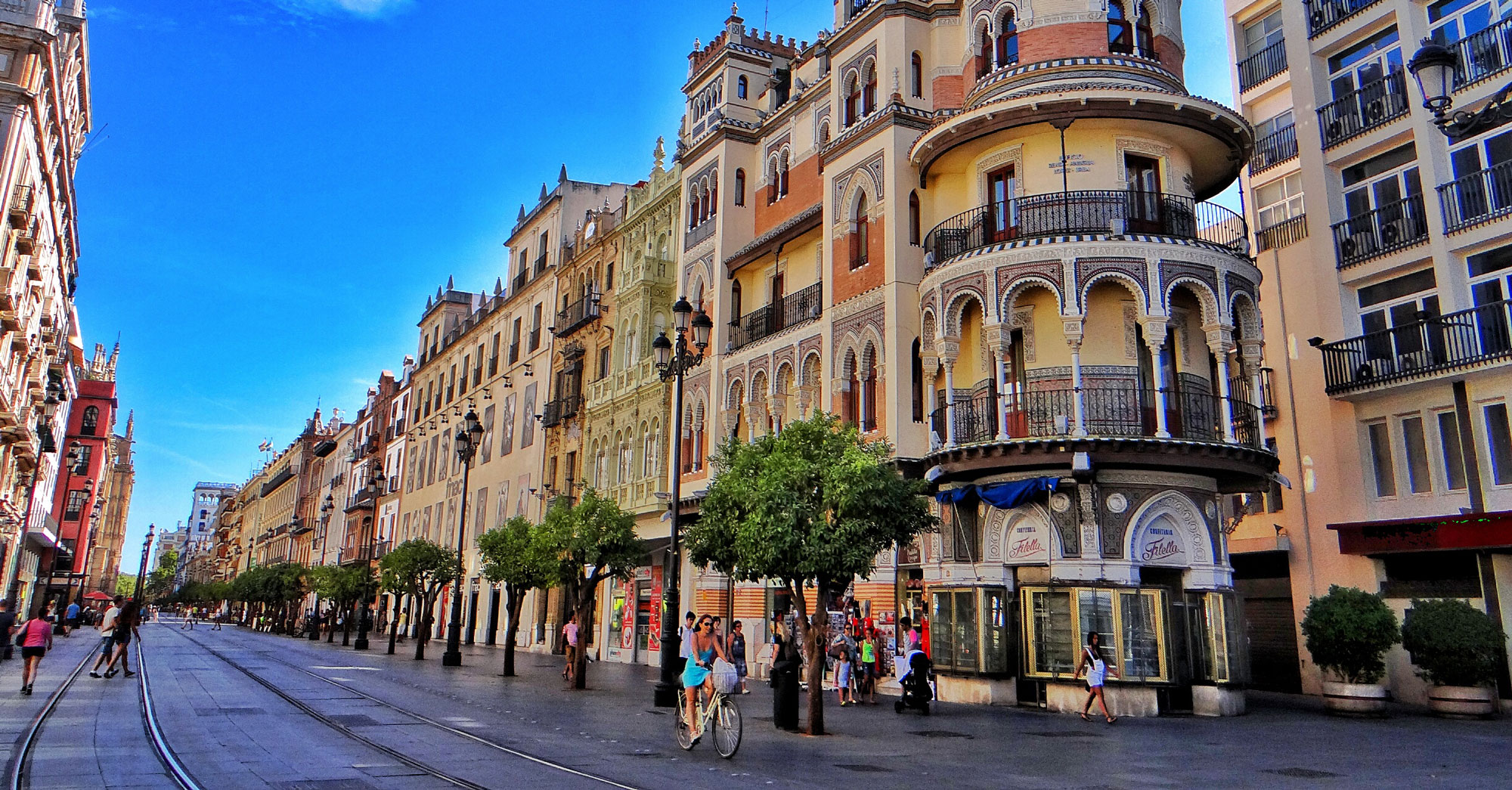
We start from the Constitution Avenue (1), considered the most important in the old town, which also has numerous cafes to start the day with a good breakfast. From here we will get to the first stop: Cathedral and (We recommend getting your tickets in advance as there are usually quite a few queues). Seville Cathedral (2), occupies the space of the old mosque, of which today only the Patio de Los Naranjos and some walls remain. Gothic style, it is the third largest in the world, and in it are historical treasures such as the tomb of Christopher Columbus. From inside you can access the Giralda, from which you get spectacular views of the city.
Once we leave the Cathedral through the Plaza de la Virgen de los Reyes, We will take the exit towards Plaza del Triunfo and Patio de Banderas until we reach the Reales Alcázares (3), of which we also recommend taking early entry. It is an impressive set of palaces and gardens that summarize the history of the city, a visit that takes about two hours, so we recommend La Sala de Justicia and El Patio del Yeso, The Palace of Pedro I, and finally a walk through the gardens.
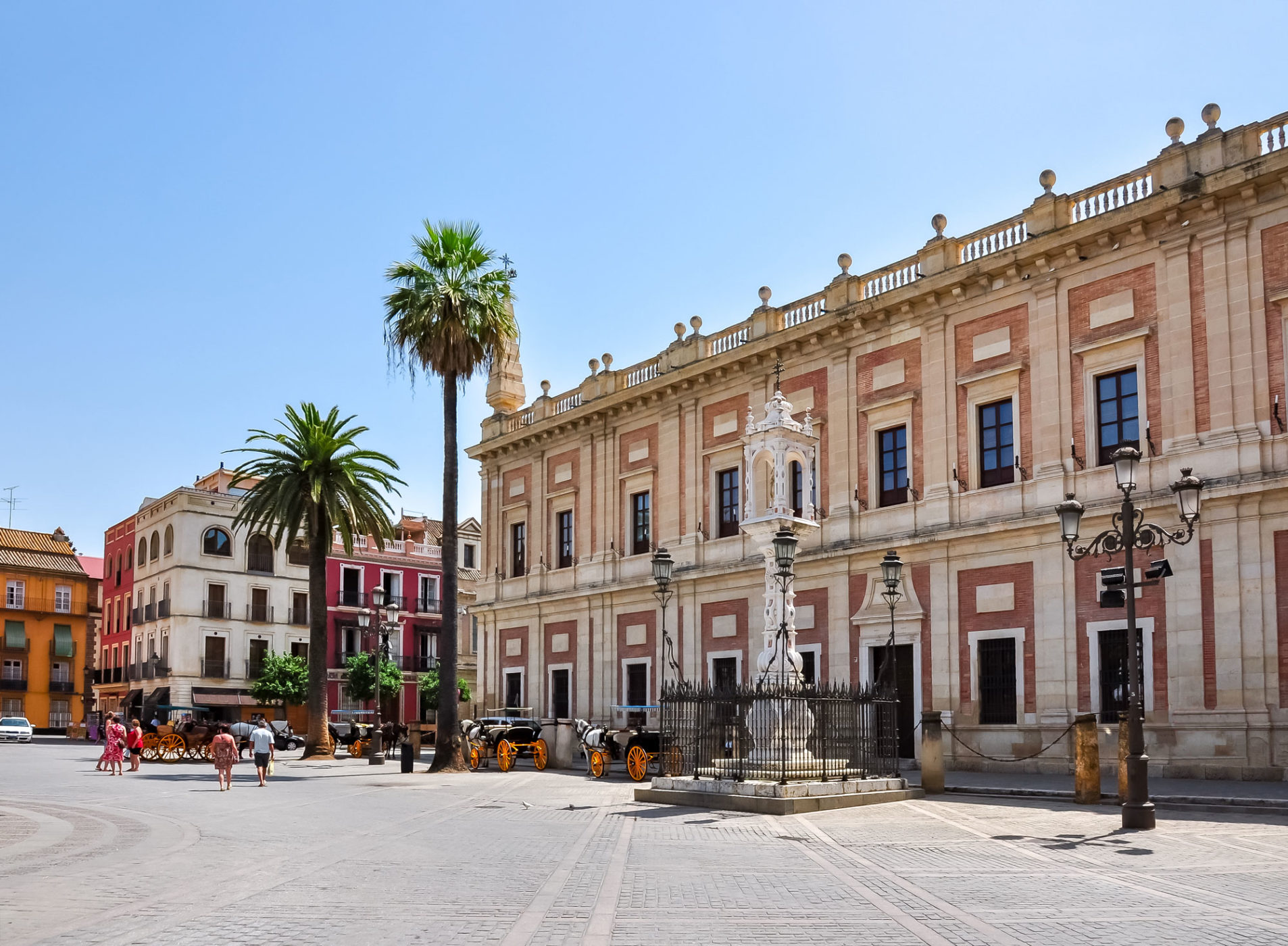
Going back to the famous avenue de la Constitución, we will get to the General Archive of the Indies (4), building that recalls its glorious past as a gateway to trade with the Indies. It is a style building Renaissance Herreriano seated on a podium with a square plan, with two floors and a large central courtyard in a square shape, combining red bricks and stone elements.
The next stop is the Santa Cruz neighborhood (5), inside which is the Real Alcázar, where we recommend visiting the famous Water Alley (6), Formerly known as “Muro del agua”, a street that runs close to the city wall and which had two tubes that carried water inside., to finish taking a walk through the narrow streets that make up this amazing neighborhood. In this area we will find a large number of bars to have a "tapa" and enjoy the Sevillian atmosphere.
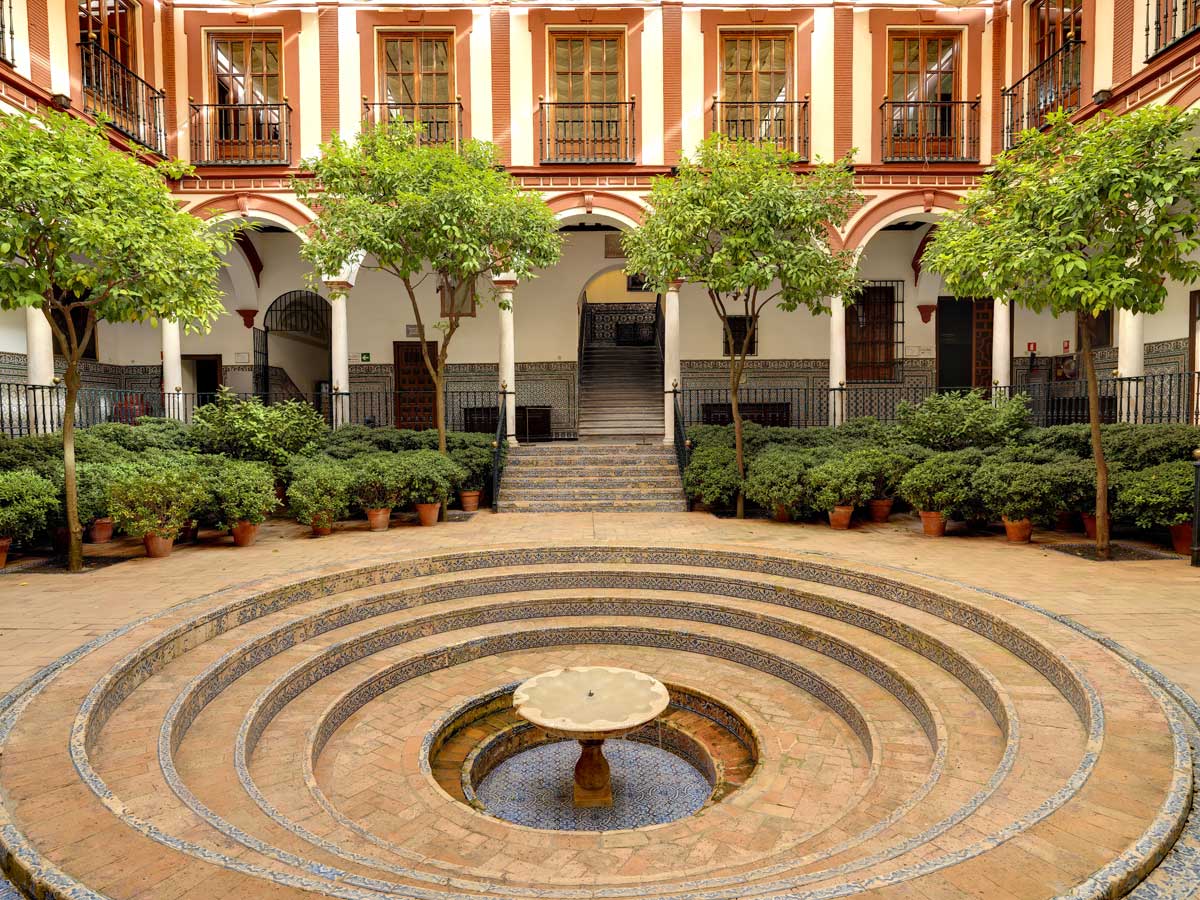
Another important point within this area, is the Hospital de los Venerables (7) and the Diego Velázquez Center, (8) which was founded on 1675 and is currently the headquarters of the Focus Foundation. It has a central patio and its church contains paintings by Valdés Leal and Lucas Valdés.
A few meters away is our next destination, the Interpretation Center of the Jewish Quarter (9), which aims to rescue the memory of the Sephardic people of Seville, to learn more about the places and characters of the Jewish quarter of Seville.
We continue the first day with the Salinas House (10): a 16th century palatial house built under the Renaissance influence that Seville experienced at a time when it was an important metropolis in commercial traffic with America. Following the route we will go to the Murillo Gardens, orchards in the gardens of the Alcázar of Seville.

Until the beginning of the 20th century, the place occupied by Murillo Gardens (11) they were orchards (Huerta del Retiro) from the gardens of the Alcázar of Seville. They were designed by Juan Talavera and Heredia, Nevertheless, in 1918, Jose Laguillo, director of the newspaper El Liberal, proposed the name change, dedicating the gardens to the painter Bartolomé Esteban Murillo.
Walking along Avenida Menéndez Pelayo we reached our next destination, the Santa Maria la Blanca Church (12), name that receives the same street in which it is located, It was built on the site of an old Jewish synagogue. Among the many treasures that we can find inside, The paintings of the Sagrada Cena by Murillo and the Pietà by Luis de Vargas stand out..

A few minutes walk, passing through the Plaza de Los Zuarradores, is the Pilate's House (13), former residence of the Dukes of Medinaceli and Alcalá. Among the many elements that were imported for its construction from Genoa, they highlight the entrance cover, the columns and the fountain in the main courtyard. Contains tiles made in the 16th century.
- Maria Luisa Park
Direction: Paseo de las Delicias s/n, 41013 Sevilla
Schedule: Monday to Sunday from 8.00 a 22.00 h - Spain Square
Direction: Avda. Isabel la Católica s/n, 41004 Sevilla
Schedule: does not have a predetermined schedule * - San Telmo Palace
Direction: C / Palos de la Frontera, 41004 Sevilla
Schedule: Monday to Friday of 9.00 a 19.00 h - other days closed
Phone: 955001010 - Torre del Oro
Direction: Paseo de Cristóbal Colón, 41001 Sevilla
Schedule: Monday to Friday of 9.30 a 18.45 h, Saturdays and Sundays of 10.30 a 18.45 h.
We recommend checking the ticket price and booking in advance. *
Phone: 954222419 - Naval Museum of Seville
Direction: Inside Torre del Oro, Paseo de Cristóbal Colon - Real Maestranza de Caballería - Seville Bullring
Direction: Paseo de Cristóbal Colón 12, 41001 Sevilla
Schedule: Check the opening hours and prices of the tickets on the phone provided. *
Phone: 954224577 - Bullfighting Museum
Direction: Interior of the Bullring - Plaza Nueva and Town Hall
Direction: Plaza Nueva 1, 41001 Sevilla
Town hall schedule: Monday to Thursday from 9.00 a 14.00 and of 16.00 a 18.00 h, Friday of 9.00 a 14.00 h - other days closed
Phone: 955010010 - Church of El Salvador
Direction: Salvador Square, 3
Schedule: Monday to Saturday from 11.00 a 17.30 h, and Sundays of 15.00 a 19.00 h.
Phone: 954211679 - Museum of Bellas Artes
Direction: Museum Square, 9
Schedule:
Phone: - Palace of the Countess of Lebrija
Direction: Cuna Street 8
Schedule: Monday to Sunday 10.30 a 19.30 h. - Flamenco dance museum
Direction: C / Manuel Rojas Marcos, 3
Schedule: Monday to Sunday from 10.00 a 19.00 h.
Phone: 954340311
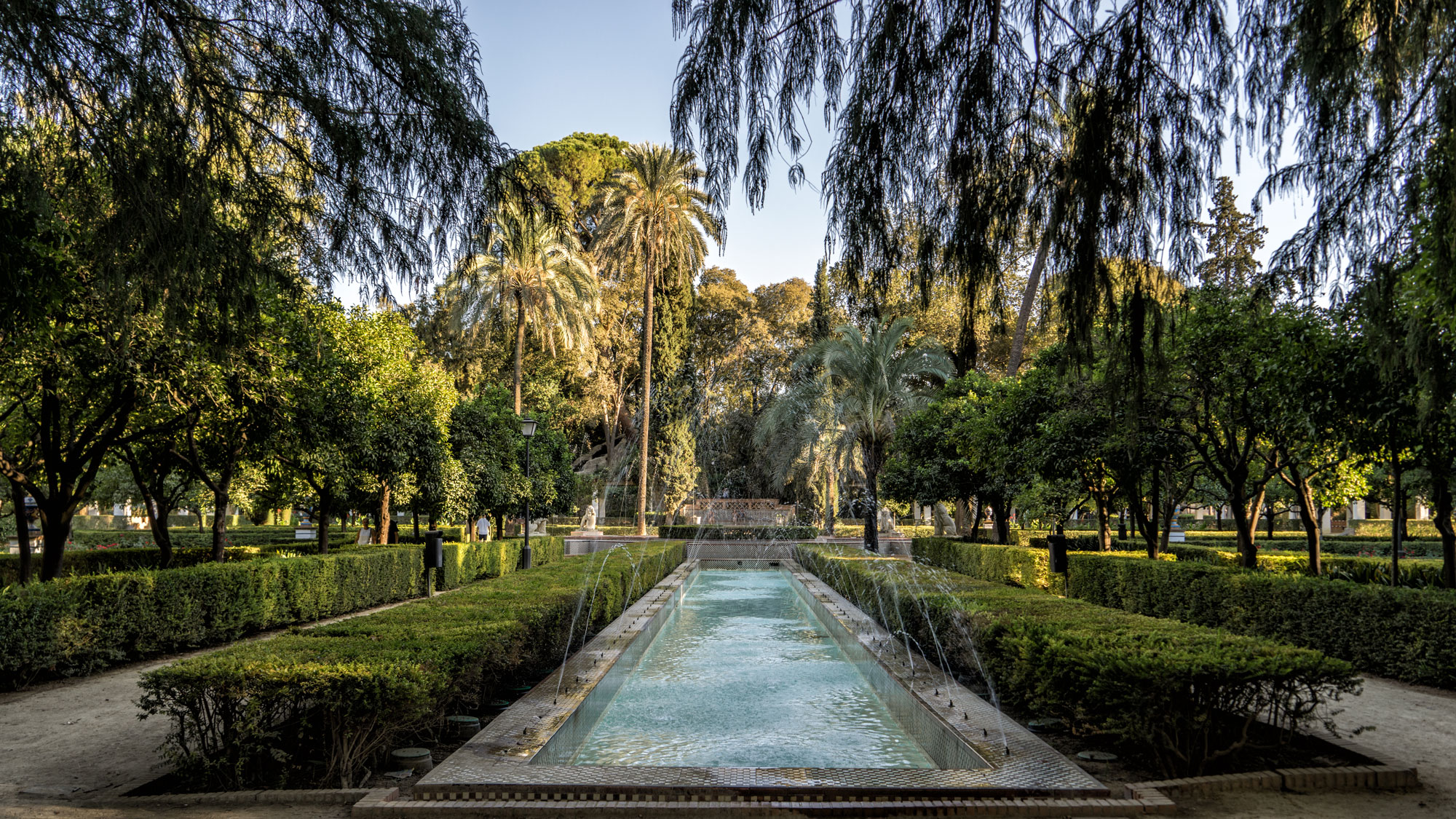
We will start our second day walking through the Maria Luisa Park (1), one of the best known and most loved gardens in the city. They were donated to the Sevillians by María Luisa Fernanda de Borbón in 1914. It is totally recommended to get lost in its labyrinthine paths, ponds, fountains and abundant vegetation.

This walk will take us to the most impressive square in Seville: Spain Square (2). In it are the names of all the provinces of Spain. It was projected for the Ibero-American Exhibition of 1929 by the architect Aníbal González, and currently maintains all the gallantry and the romantic halo, that have made it an absolutely unique space, where to enjoy a boat ride or ideal waffle stands.
We continue crossing the avenue of El Cid, and the gardens of San Telmo, to get to the San Telmo Palace (3) , which was property of the Court of the Inquisition, Seminary College of the Merchants University, Navy College, headquarters of the Railway Society or the Literary University, until it became what we now know as the official seat of the presidency of the Junta de Andalucía.

Walking along the Paseo de las Delicias you will find the next destination, The Torre del Oro (4), but before arriving, it is the perfect area to regain strength. Located on the left bank of the Guadalquivir river and with a height of 36 meters, was declared historical-artistic monument in 1931, and houses the Naval Museum of Seville (5).
After that, We will take the Paseo de Cristóbal Colón to the right, to get to the Royal Cavalry Maestranza, Y Seville bullring (6). It is in the Baroque style and was built in the 17th century.. The Bullfighting Museum (7) It is located inside the building that was inaugurated in 1989. In 2008 the princes Felipe de Borbón Y Leticia Ortiz new rooms opened, where are they also, 18th century paintings, XIX and XX, bullfighting posters, bullfighting costumes, bronzes, tiles and sculptures.
To get to our next stop we will walk through emblematic streets full of bars for "tapas", like Harinas street, Arfe on Zaragoza, until ending in Plaza Nueva (8), where the Seville City Council is located. The historic building that occupies the Town Hall constitutes one of the most notable examples of Renaissance architecture.
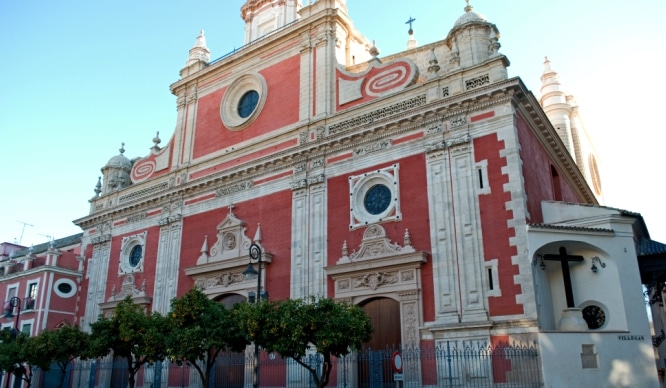
Going up the Plaza de San Francisco, behind the Town Hall, we got to the next stop: the Church of El Salvador (9). It is the second most important temple in the city after the Cathedral and is located in the old Roman forum. The current temple is a work of the 17th century in Baroque style and inside there are two great works of art: the crucified by Juan de Mesa (Christ of Love) or the Christ of Passion, work of Martínez Montañés, which procession during Holy Week. This church is located in a square with numerous bars to take a break and enjoy the tapas of Seville.
Crossing the emblematic neighborhood of Alfalfa, and walking down Alfonso XII street, we got to the Museum of Bellas Artes (10). This is, the most relevant museum in Seville, and the second art gallery in Spain, where a valuable collection of painting from the baroque school is preserved, in addition to other large-scale exhibitions. For residents of the European Union, entrance is free, and on Sundays there is usually a market in the Plaza del Museo.

We go back down Calle Alfonso XII, until reaching the Palace of the Countess of Lebrija (11), an example of a Sevillian palatial house, with large mosaics from the ancient Roman villa of Italica, while collecting archaeological remains of great value.
Our last destination of the day is one of the most characteristic places in the city: the Flamenco Dance Museum (12). It is an 18th century building and reflects the origins and evolution of flamenco throughout history, as well as its categories and main artists.
- Metropol Parasol
Direction: Plaza de la Encarnación s / n, 41003 Sevilla
Schedule: Monday to Sunday from 9.30 a 22.30 h.
Phone: 606635214 - Antiquarium
Direction: Plaza of La Encarnación (37), 41003 Sevilla
Schedule: Tuesday to Saturday from 10.00 a 20.00 h and Sundays of 10.00 a 14.00 h.
Phone: 955471580 - Palace of Las Dueñas
Direction: C / Dueñas, 5
Schedule: Monday to Sunday from 10.00 a 17.15 h.
Phone: 954 214 828 - Palace of the Marquis of la Algaba
Direction: Plaza Calderón de la Barca sn
Schedule: Monday to Friday of 10.00 a 14.00 h and from 18.00 a 21.00 h, Saturdays from 10.00 a 14.00 h - sunday cerrado
Phone: 955 472 525 - Fair Street
- Church of San Luis de los Franceses
Direction: San Luis Street 37
Schedule: Tuesday to Sunday from 10.00 a 14.00 h and from 16.00 a 20.00 h - Monday closed - Convent of Santa Paula
Direction: Santa Paula street 11
Schedule: check schedule by phone *
Phone: 954 536 330 - Rest of the Walls and Arco de la Macarena
- Basilica of the Macarena
Direction: Becquer Street 1
Schedule: Monday to Sunday from 9.00 a 14.00 h and from 17.00 a 21.00 h.
Phone: 954 901 800 - Hospital of Las Cinco Llagas - Parliament of Andalusia
Direction: Parlamento de Andalucía, 41009 Sevilla
Schedule: Monday to Sunday from 8.00 a 22.00 h.
Phone: 954595929
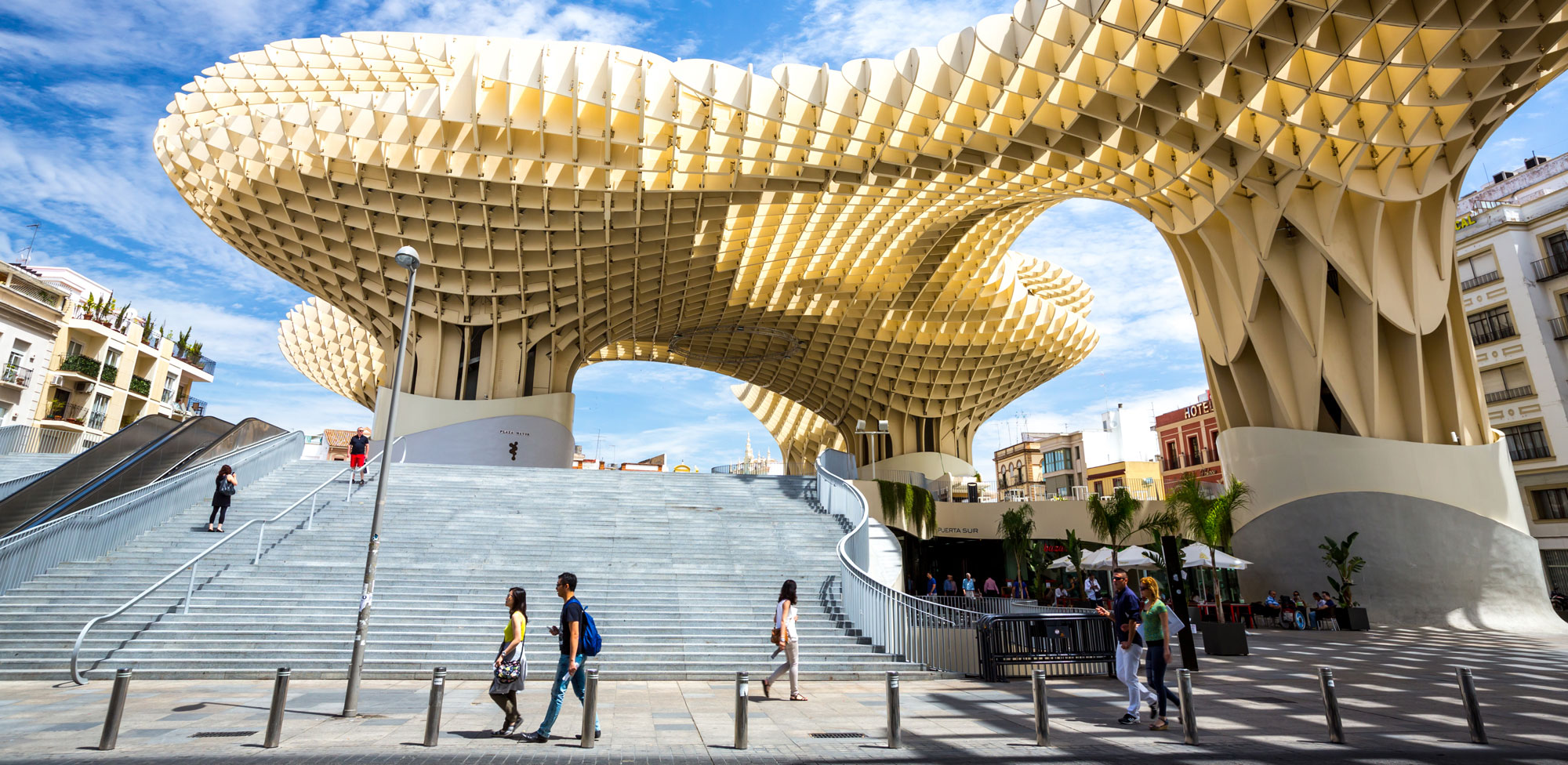
Our route begins in the Plaza de la Encarnación, where the famous "Seville mushrooms" are found, area also known as Metropol Parasol (1). It is a curious viewpoint that rises above the roofs thanks to the largest wooden structure in the world. Under the foundations of this curious construction, Roman and Arab remains were discovered that have been integrated into the space through a small site museum, the Antiquarium (2).
From here we will take Santa Ángela de la Cruz street, street in which we find the convent from which it receives its name, It is advisable to enter if it is open, until reaching the Palace of Las Dueñas (3), which was the Sevillian residence of the Casa de Alba. Its style ranges from Gothic-Mudejar to Renaissance, containing samples and details with Sevillian touches on its bricks, tejas, tiles, whitewashed and ceramics, it also has the typical Andalusian patio.

The Feria street (5) will take us to our next destination: the Palace of the Marquis of la Algaba (4). It is one of the best examples of Mudejar architecture in Seville, where the Mudéjar Art Center of Seville is located.
A few minutes walking, is the Church of San Luis de los Franceses (6), a prominent example of 18th century Baroque architecture, designed by Leonardo de Figueroa, Nevertheless, currently belongs to the Diputación de Sevilla.
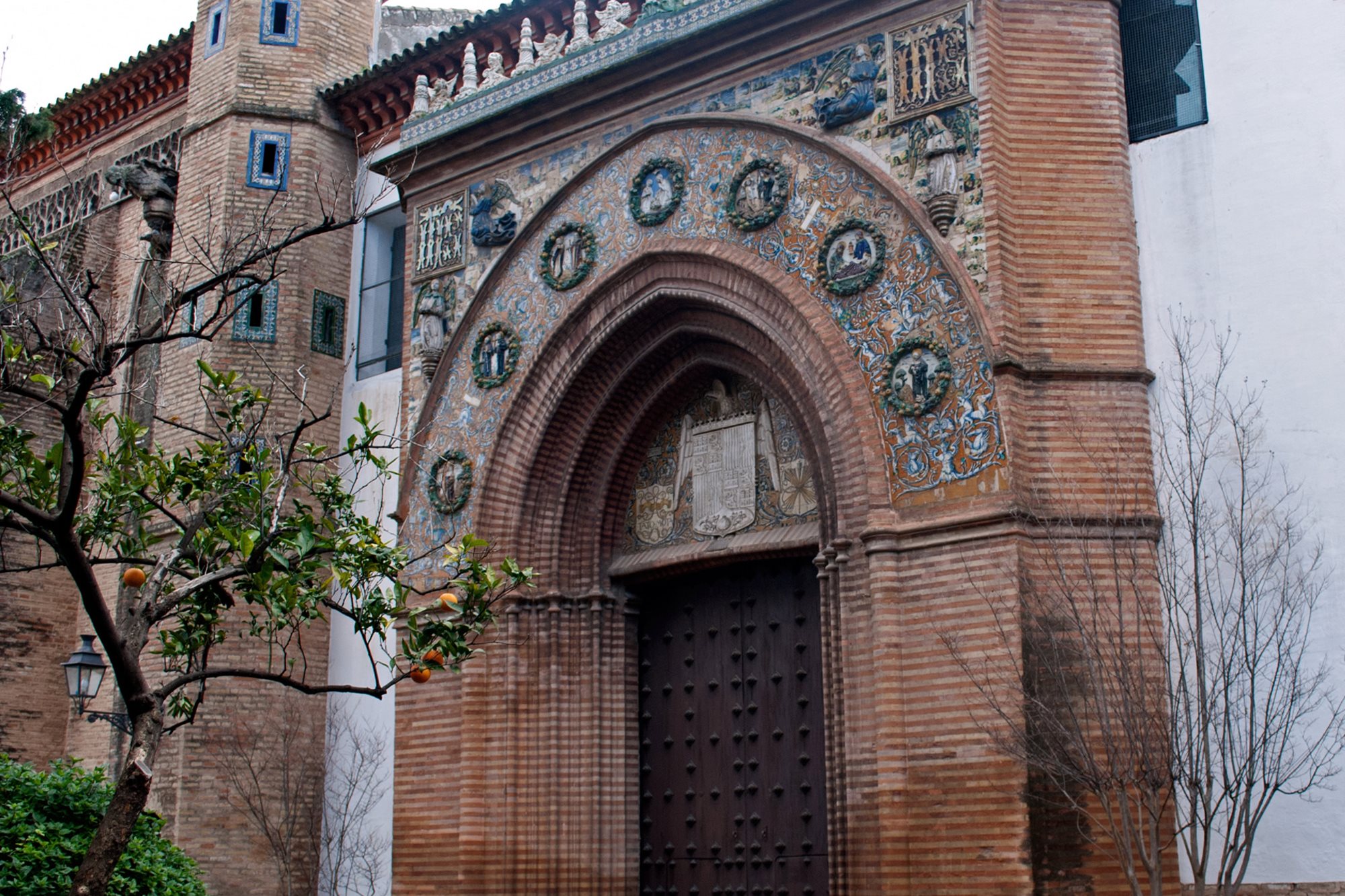
Passing by the Church of San Marcos, we got to the next stop: the Convent of Santa Paula (7). This is a monastic cloistered monastery of nuns of the Order of Saint Jerome. It was founded in the 15th century and has a rich artistic heritage that its sisters have dedicated themselves to caring for.. You can also buy some of its delicious handcrafted products, like jams, membrillos, bacon from heaven ... a pleasure for the palate.
In this area of the Macarena neighborhood, are the remains of the Walls and the Arch (8).The walls were built during the Islamic occupation stage, and The door or Arco de la Macarena is together with the oil shutter and the Córdoba door the only three accesses that are currently preserved from the walls.
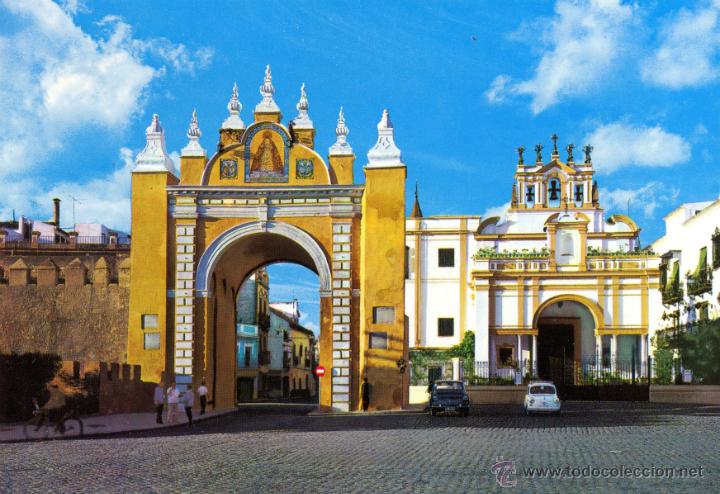
Walking through this same area, we meet the Basilica of the Macarena (9), contemporary architecture temple, that venerates one of the most famous images of Holy Week inside and outside our city, the Virgin of the Macarena. In its museum you can learn about the history of this brotherhood and contemplate the belongings and accessories that are used in its penance station.
Our next and last destination of the day is the Hospital of the Five Wounds (10), Renaissance building designed by Martín de Gainza, performed an important care work. It is currently the headquarters of the Parlamento de Andalucía, so for your visit it is necessary to make a prior reservation.
- Alameda de Hércules
- Basilica of the Great Power
Direction: San Lorenzo Square 13
Schedule: Saturday to Thursday from 8.00 a 13.00 h and from 17.30 a 21.00 h, Friday of 7.30 a 22.00 h.
Phone: 954 915 686 - Convent of Santa Clara
Direction: Becas street s / n
Schedule: check schedule by phone *
Phone: 955 471 302 - Monastery of San Clemente
Direction: Reposo street 9
Schedule: Monday to Friday of 10.00 a 13.00 h and from 16.45 a 18 h, and Saturdays of 16.00 a 18.00 h.
Phone: 954378040 - Tower of the Perdigones (Dark tower)
Direction: Resolana street 42
Schedule: Tuesday to Sunday from 13.00 a 24.00, closed Monday.
Phone: 954909353 - Triana neighborhood
- Santa Ana Parish
Direction: Parish priest Don Eugenio 1
Schedule: Sunday to Friday from 10.30 a 13.30 h, and of 16.30 a 20.30 h, Saturdays from 20.00 a 21.30 h.
Phone: 954270885 - Chapel of the Sailors
Direction: Purity Street 51
Schedule: check schedule by phone *
Phone: 955 010 010 - Basilica of the Puppy
Direction: Castilla Street 182
Schedule: Monday to Saturday from 10.00 a 13.30 h and from 17.30 a 21.00 h, and Sundays of 10.00 a 14.00 h.
Phone: 954333341 - Triana Ceramic Center
Direction: Callao street 16
Schedule: Tuesday to Saturday from 11.00 a 18.00 h.
Phone: 955 474 293 - Castle of San Jorge
Direction: Plaza del Altozano s / n
Schedule: Tuesday to Saturday from 10.00 a 17.00 h, Sundays from 10.00 a 14.30 h - Monday closed
Phone: 954 332 240 - Triana Market
Direction: San Jorge Street 6
Schedule: Monday to Saturday from 9.00 a 15.00 h; leisure and restoration of 10.00 a 24.00 h.
Phone: 674 074 099

This route starts at Alameda de Hércules (1), one of the most atmospheric areas of the city. It was created by the Count of Barajas, and at its southern end there are two columns from the Roman temple on Calle Mármoles, that were crowned with the sculptures of Julius Caesar and Hercules, considered as the founders of the city.
Crossing Santa Clara street, we arrived at our next stop: the Basilica of the Great Power (2). Considered one of the most famous temples in the city due to the large number of visits it receives and the number of devotees. Inside is the Christ of the Great Power, that processions at dawn on Good Friday.
From here we walk up the Convent of Santa Ana(3). An old Almohad palace that later belonged to Don Fadrique, and then it became a convent of the company of the Poor Clares until 1998. It currently has a cultural use and is the venue for different cultural events.
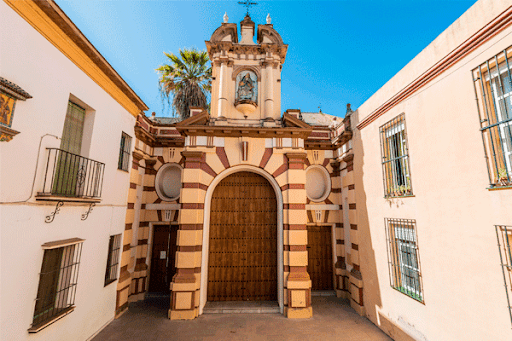
In this area you can find numerous bars, so it is the perfect time to take a break and enjoy the atmosphere. Once the forces are restored, we continue along the Avenida de Torneo, until the Monastery of San Clemente (4), This belongs to the Cistercian order and is the oldest monastery in the city, its foundation dating back to the second half of the 13th century. Prior reservation is required for your visit.

The next destination is across Calle Resolana, and is the Tower of the Perdigones (5), also known as the Dark Tower or the Pellet Factory. Nevertheless, the name of Torres Oscura receives it for its current use, since it works as a camera obscura from where you can see the city at a height of 45 meters.
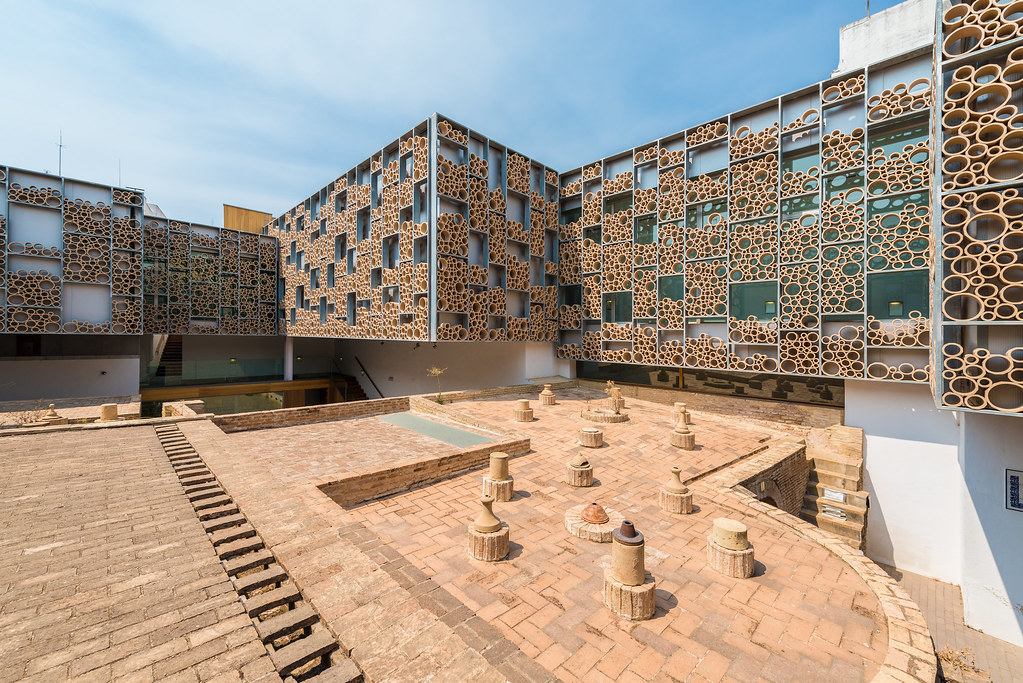
After visiting the previous destination, we take the bus 03 in Councilor Jiménez Becerril – Barqueta, to get off at the Arjona stop- Triana bridge, to get to Triana neighborhood (6). This neighborhood, is located on the west bank of the river, and offers many attractions to visit: beautiful churches like the Santa Ana Parish (7), built in the 13th century, the oldest and most important in the area; the Chapel of the Sailors (8), where is the image of the Virgin Esperanza de Triana; or the Basilica del Cachorro, seat of the magnificent image of Cristo del Cachorro. What's more, Triana, among other reasons, is famous for its ceramic and pottery tradition, For this reason and to know its history and evolution, a visit to the Triana Ceramic Center (9), located in an old ceramic factory; in this center you can visit the manufacturing part as well as a permanent exhibition of ceramic pieces made in different artistic styles.

In the Triana neighborhood, we also find the Castle of San Jorge (11), ancient Almohad castle, headquarters of the Spanish Holy Inquisition of 1481 a 1785 and symbol of this institution in Europe, where you can see very well preserved archaeological remains from that historical period. Inside it is the famous Triana Market (12), in which you can see the atmosphere of a typical Sevillian market, as well as enjoying our gastronomy in its bars.
- Seville Tower
Direction: Gonzalo Jiménez de Quesada Street 2
Schedule: check schedule by phone *
Phone: - Forum Box
Direction: CC Torre Sevilla, López Pintado Street
Schedule: Monday to Sunday from 10.00 a 20.00 h
Phone: 955 657 611 - Navigation Pavilion
Direction: Path of Discoveries 2
Schedule: Tuesday to Saturday from 11.00 a 20.30 h, Sundays from 11.00 a 15.00 h - Monday closed
Phone: 954 043 111 - Cartuja Monastery
Direction: Américo Vespucio street 2
Schedule: Tuesday to Saturday from 11.00 a 21.00 h, Sundays from 11.00 a 15.30 h - Monday closed
Phone: 955 037 070 - Andalusian Center of Contemporary Art
Direction: Américo Vespucio street 2
Schedule: Tuesday to Saturday from 11.00 a 21.00 h, Sundays from 11.00 a 15.30 h - Monday closed
Phone: 955 037 070 - Seville Aquarium
Direction: Muelle de las Delicias s/n
Schedule: Monday to Friday of 10.00 a 19.00 h, Saturdays and Sundays of 10.00 a 20.00 h.
Phone: 955 441 541

The route of our last day will be through what is known as "Isla de la Cartuja" and begins in Seville Tower (1), the first skyscraper built in the city, and the highest in Andalusia, with a height of 180,5 meters and 37 floors, It was built by the architect Cesar Pelli. We recommend going up to the viewpoint, to enjoy one of the most spectacular views of Seville.
From here we move a few meters to the Caixa Forum (2), located in the same shopping center where the tower is located, is the third most important. Has a surface of 7.500 m2 and was designed by the architect Guillermo Vázquez Consuegra. It has two exhibition halls, an auditorium for 276 plazas; two multipurpose rooms, workshops, cafeteria and a bookstore-shop.
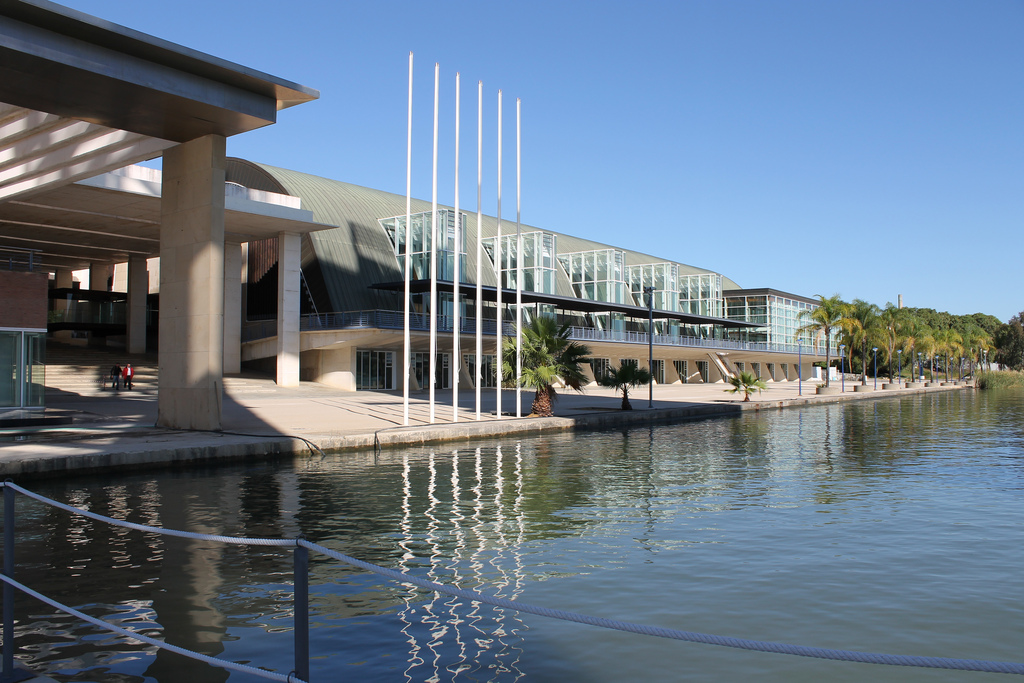
The next stop is the Navigation Pavilion (3), built for the Universal Exhibition of 1992. It was one of the most important, due to the importance of navigation in the history of Seville. This space offers the possibility that families and children, especially, you can learn about some stories and experiences of some sailors who crossed the ocean in search of a new life.
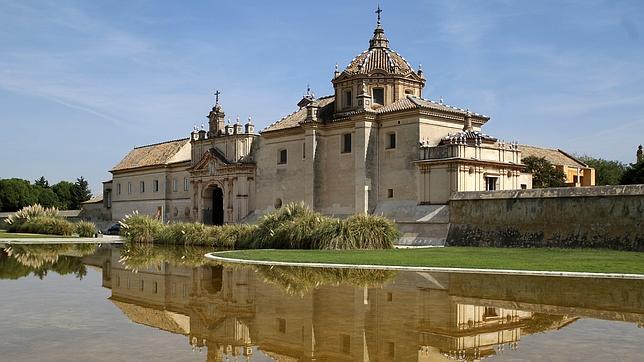
Within this same area, is the Cartuja Monastery (4), in honor of Santa María de las Cuevas. Among its peculiarities, we find that the body of Christopher Columbus was buried in this monastery during 30 years, since his monks welcomed him and prepared him for his trip. Few years later, lost its religious character, It was sold to the English industrialist Charles Pickman who established a ceramic and porcelain factory. During the Universal Exhibition of 1992 It was used as the Royal Pavilion, Nevertheless, currently welcomes the Andalusian Center for Contemporary Art (5).

To finish the route, we propose a visit to Seville Aquarium (6), located on the Muelle de las Delicias, a fantastic experience for both adults and children. Dispose of 35 different aquariums containing animals belonging to more than 400 different species. It has an oceanarium of about two million liters in volume and a water column of almost 9 meters high. To get to the aquarium from Isla de la Cartuja, It is necessary to take the C2 bus at Américo Vespucio-Monasterio de la Cartuja and get off at the Glorieta Marineros Voluntarios stop.